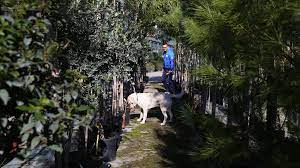Italy: Plan to save dying olive trees with dogs

Agostino Petroni
Rome: On a sunny winter morning, the dog trainer Mario Fortebraccio slowly bends toward a line of potted olive trees and indicates it with his hand. Waiting for that signal, Paco, a three-year-old white Labrador, rushes through the row of plants with his head tilted, sniffing each pot at the root, the rhythm of his inhaling echoing through the greenhouse. The dog is carefully scouting for something humans can’t sense.
“They don’t do anything if there is no reward,” Fortebraccio tells me with a smile. After a few seconds, having completed his task, Paco returned to the trainer, lifted his leg to urinate on a nearby plant, wagged his tail, and claimed a little crunchy treat.
At Vivai Giuranna, an extensive commercial greenhouse with over one million plants in Parabita, in the southern Italian region of Puglia, Paco is searching for Xylella fastidiosa, a type of bacterium that has been ravaging southern Italy’s olive fields for the past decade. Paco and a few other four-legged colleagues make up the highly trained Xylella Detection Dogs team.
“These dogs have got something unique,” says Angelo Delle Donne, the head plant health inspector for the government of the province of Lecce, who has been battling Xylella since it was discovered in Puglia in 2013.
Xylella fastiodiosa is a bacterium that clogs the xylem (the vessels that carry water from the roots to the leaves) of trees and other woody plants and slowly chokes them to death. Spittlebugs, a common insect, spread the disease: when they bite an infected leaf, the bacteria move into their saliva, and the bugs transmit the disease when they feed on their next healthy plant.
There are no known cures for this disease, and once infected, the plant slowly dries up (though some infected plants manage to survive without showing symptoms). There are several strains of Xylella, and together they affect 595 plant species worldwide at the last count. Over the past century, Xylella has decimated orange fields in Brazil, vineyards in southern California, and pear trees in Taiwan. Then, 10 years ago, Xylella reached Puglia’s olive trees.
With its 60 million olive trees, Puglia used to produce up to 50% of Italy’s olive oil, but in just a few years, Xylella infected and killed 21 million trees, many of which were several centuries old.
Today, an endless sea of dead, grey tree trunks covers the lower part of the region, dotted with what’s left of thousands of small-scale farms, olive mills, and greenhouses.
Mauro Giuranna, the owner of Vivai Giuranna, has personal experience of a Xylella attack. When plant inspectors found infected plants in his greenhouse, he had to dispose of about €1m ($1m/£900,000) worth of plants.
“We were too superficial [in countering Xylella] in the first years,” Giuranna says. “There are no more monumental olive trees left.”
He wishes controls had been tighter and faster. However, the regional governor President Michele Emiliano was initially sceptical about a link between Xylella and the rapid desiccation of olive trees.
The scientists working on trying to stop the bacteria were put on trial, accused of spreading the bacteria themselves (eventually, all charges were dropped). Italy was investigated by the European Commission for an inadequate response.
A spokesperson for Emiliano told Future Planet that he had never endorsed anti-scientific or conspiracy theories. “The President has launched an important action of listening to everyone, organising public assemblies, personally participating in all the events to which he was invited, to bring an issue as complex, dramatic and divisive as Xylella into the context of a civil dialogue,” the spokesperson said.
Italy’s response has now improved since the early days after the infection, taking measures such as large-scale disease monitoring. However, Xylella keeps spreading through the region’s olive fields.
“We are always chasing the disease,” says Delle Donne.
As the bacteria keeps spreading northward at a rate of about 20km (12 miles) per year, popping up in other regions of Italy and Europe too, governments are concerned, while scientists and plant inspectors are racing to contain the disease and prevent it from spreading further. Once an infected tree is identified close to healthy trees, it has to be uprooted and any other trees in a 50m (160ft) vicinity are carefully inspected.
Nicola di Noia, an agronomist from Taranto and the general director of Unaprol, Italy’s largest olive oil producers’ consortium, understands the danger of Xylella well and loudly advocates for its containment.
“It is an unprecedented ecological, environmental disaster,” he says. “We can’t just get caught up in environmentalist passion. We have to be scientific.”
In 2020, he thought of his past experience as a carabiniere (an officer for Italy’s gendarmerie), working with molecular-detection dogs for uncovering drugs and explosives and remembered their incredible olfactory skills. What if they could detect Xylella too?
“We began looking for similar works done by dogs on plants,” Di Noia says. And they found that a team of Californian experts had figured out a way to use smell to detect bacteria on citrus fruits.
Excited by the possibility, Di Noia spoke about this idea with the Ente Nazionale della Cinofilia Italiana (ENCI, the national organisation responsible for the recognition, standardisation, and registration of pedigree dogs in Italy) and with the head researchers on Xylella in Bari, Puglia’s capital, at the National Research Council.
He put together the funds and decided to call in the cavalry – the Xylella Detection Dogs.
Dogs like Ellis have exceptional noses but they also have other crucial traits, such as intelligence and a keen desire to play (Credit: Agostino Petroni)
Dogs like Ellis have exceptional noses but they also have other crucial traits, such as intelligence and a keen desire to play (Credit: Agostino Petroni)
A dog’s nose, in principle, works the same way as a human’s does. As we inhale and exhale, receptors in the nose detect molecules in the air and send the information to the brain.
A dog’s nose has a few different features that make the animal a super-smeller. Its front part of the nose serves to humidify the incoming air which aids olfaction, and the air is then pumped to the lungs, and in part, into an olfactory chamber packed with receptors to catch odorants. And that’s where dogs outclass the human nose: dogs have 20 times more olfactory receptors than humans that send signals to their brains. When the dog exhales, the air goes out through the two side slits of the nose, not through the nostrils as we do: this is why dogs can sniff in a continuous cycle, catching large volumes of air and odorants.
“There are animals that see a lot more colours than we do,” said Adee Schoon, an independent Dutch biologist who has been working with scent detection by animals for the past three decades. “If you take that analogy and use it with dogs, you can see that we are definitely odour-blind compared to dogs.”
Most dogs can navigate the scent world in ways we cannot fathom, but it takes special individuals and a lot of training to become detection dogs. Schoon used to work with detection dogs in forensics, in particular rape cases for the Dutch police, to identify rapists by their semen. She says to think of detection dogs as highly trained specialists who recognised scents in the way humans recognise people’s faces.
However, training a new dog is not easy and can take some time. According to Serena Donnini, a dog trainer for ENCI and the coordinator of the Xylella Detection Dogs experimental programme, there are some dog breeds, such as the springer spaniel, German shepherd, cocker spaniel, and Labrador, that, thanks to their larger nose and chest space, are more likely to become good super smellers and work longer shifts in a self-directed way, often pursuing a scent for hours. But that’s not enough, Donnini says, because a dog’s personality is important too: to pass all the exams to become a detection dogs, the animals must love to play and eat.
“This is important in order to develop a reward system,” Donnini says. The more a dog loves to catch a ball, and the more they become obsessed with it, the more likely they’ll look for it. “Until we have something that the dog wants so strongly that he would almost be willing to kill to get it, we can’t move forward to train him.”
A common object that Donnini and her colleagues often work with is a hollow rubber toy. After letting the dog initially play with it, trainers start hiding it to work on the dog’s searching skills. Every time the dogs find the rubber, they receive a food reward.
“It must think, ‘working here is great because I found my toy’,” Donnini says. To the dogs, the rubber has a very specific odour, so the more the training advances, the more the trainer breaks the rubber into smaller pieces until they become the size of a lentil. The smaller the rubber fragment, the more the dog concentrates on finding it and speeds up its sniffing frequency. Once the dog is taught how to indicate it has found the toy by freezing, barking or sitting, trainers insert the target smell.
According to Donnini, there are different ways to do this, but there are two most common methods. The first is pairing – putting together target smell and toy, rewarding the dog when they find them, and slowly removing the rubber of the toy. The other is contrasting – here, no toy is hidden, but as the dog urgently looks for it, when it passes by the target odour, it receives a reward. The dog soon learns to signal when it recognises the new smell, receiving a reward.
Therefore, Donnini says it’s crucial to train the dogs with the right scents, and this is where the scientists of the National Research Council play a fundamental role. To save trees from Xylella, that scent is the odour of an infected plant. Like humans, when plants get infected, their metabolism and scent change.
Donato Boscia, a plant virologist and the head of the Bari unit of the CNR Institute for Sustainable Plant Protection in charge of studying Xylella, has been providing Donnini with certified infected olive plants. Boscia’s team is currently trying to figure out the specific molecules released by the infected plants that the dogs perceive.
“We don’t really know, but we have to give the dog all the puzzle pieces so that he can create a precise smell image,” Donnini adds.
To show the dogs’ precision, Donnini lays out five small potted olive trees in a row in the yard of Forestaforte, an olive mill, and the research outpost of CNR in Salento. One of the plants carries a tag with a red dot, certified as infected with Xylella by Boscia’s team. Dog trainer Fortebraccio signals to Ellis, his seven-year-old dappled white and brown springer spaniel, who sprints through the plants, freezes in front of the infected plant, and wagging her tail, returns to the trainer to claim her food.
No matter where the plant was positioned in the line, both Ellis and Paco could clearly spot and freeze in front of it.
Not all plants infected by Xylella show symptoms perceptible to humans, which is one reason it has proved so challenging to contain the disease. The dogs could help halt the spread at critical strategic locations such as greenhouses and ports. It’s thought that it was through an imported coffee plant from Latin America that Xylella arrived in Puglia in the first place, according to one study led by Annalisa Giampetruzzi of the University of Bari Aldo Moro.
“It is precisely these [places] that have been the Trojan horse in which Xylella was introduced into a new area,” Boscia says. They imagine trained dogs deployed in each entrance port that receives imported plants and others that would periodically scout the region’s greenhouses.
“We need to train dogs to identify Xylella-infected plants regardless of the plant species where it is found,” Boscia said. The researchers still do not know if the compounds that the dogs smell come from the roots or from the branches of the tree. They are still uncertain if, with the same training, they’ll be able to simultaneously uncover the bacteria in a rosemary or an oleander plant.
According to Cristina Davis, a professor of mechanical and aerospace engineering at the University of California, who has been working for years to build instruments that can detect volatile organic compounds, that is a possibility. She explains that if, for example, there are 50 volatile compounds emitted by each different Xylella-infected plant species, it could be that a portion of those compounds are shared between all.
“I think that there’s a really reasonable expectation that you could train an animal like a dog or a sensor to be able to detect that over time,” Davis says.
The emissions from travel it took to report this story were 118kg CO2, travelling by train and car. The digital emissions from this story are an estimated 1.2g to 3.6g CO2 per page view. Find out more about how we calculated this figure here.
In fact, in 2014, Davis and her team managed to use an advanced instrument, a differential mobility spectrometer, to spot citrus plants infected by the bacteria Candidatus Liberibacter.
As Italian scientists keep studying the infected plants, dogs could work as proof of concept to create an instrument that could help their Xylella search too. There is still a lot of work to be done, but the researchers hope the Xylella Detection Dogs will be another instrument to contrast the deadly bacteria.
Besides the dire impact of Xylella on the southern Italian territory, Di Noia worries about the quantities of carbon dioxide released into the atmosphere by the endless forests of dead olive trees as they decompose.
“It’s a cost that we all have to pay, nationally and internationally, to contain an environmental disaster,” Di Noia says.





